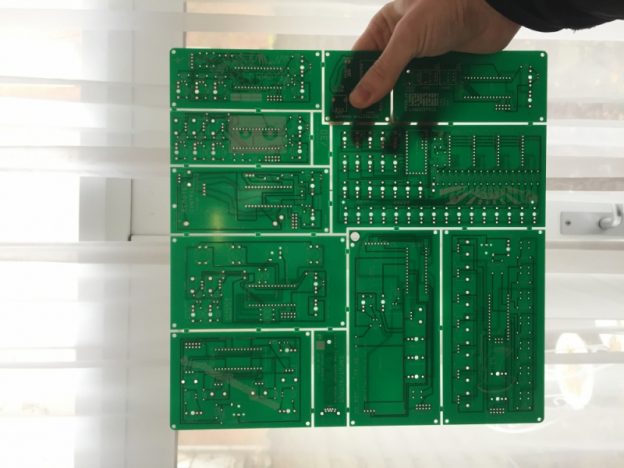Thursday 12 December 2019 | open: 20:00 | start: 20:30 | end live sets: 23:00
Location: DE PLAYER – Hillelaan 49D, Rotterdam
Admission: €8,- | Students: €6,-
DE PLAYER and Experimental Publishing XPUB / Piet Zwart Institute present:
INPUT/OUTPUT
A night about new interfaces for sound and performance arts
with:
Roc Jiménez de Cisneros (EVOL)
and the students of Experimental Publishing
—
It is time for printed circuit boards (PCB’s), patterns, deformation, imitation, stretching, remoteness, alphabets, notification, phonetics and more. Together with the students of the The Piet Zwart Institute Experimental Publishing course, we are stepping into an unstable and unknown area in which the processes and challenges for the artist are equal to those for the audience. During this evening we will present the results of a collaborative seminar on modules, in combination with different specific tools designed by Roc Jiménez de Cisneros from EVOL and other artists.
This event is part of our research project ‘)HRHED(‘, in which we investigate new social and artistic interfaces for sound and performance arts. Recently, together with Spatial Media Laboratories (SML), we presented a workshop on interfacing inaudible phenomena. In our program for next year we have already scheduled full event presentations of new works, together with ITU (Anni Puolakka & Miša Skalskis), Evelin Brosi and Caz Egelie, who are also part of this research project.
—
■ Roc Jiménez de Cisneros will present a brand new EVOL project called ‘SOUP’, a MIDI sequencer based on Hanne Darboven’s 1984 Opus 17A – a piece EVOL has been reworking multiple times since about five years ago, and this one is likely to be their last version. ‘SOUP’ is a little box that plays the original sequence of notes in Darboven’s piece, and lets you modify it by tweaking six knobs that alter a number of things such as length (from one note to the whole score), speed (from regular to f*cked *p) and so on… Basically, you can either play it conservatively (the same way as a pattern in an old-school synth), or play around with it and quickly turn Opus 17A into weird “techno”-sounding arpeggios and wonky sequences. In contrast to a conventional sequencer, you can not enter any notes. In that sense, the sequencer operates autonomously. It also doesn’t produce any sound on its own, but only sends out MIDI messages over USB – and it is entirely up to the user to decide what to do with them. It is a very conscious decision they made to ensure it will produce wildly different results in various hands. Only ten units have been made, all done by hand and very low-key.
■ Together with the students of The Piet Zwart Institute Experimental Publishing course, we have been researching new interfaces within the field of publishing. Over the course of one trimester, each of the students worked on their own sound module and tweaked it into their own conceptual project. No restrictions on INPUT. No restrictions on OUTPUT. This resulted into a series of ten multilingual printed circuit boards, offering different stand-alone devices which can be noodled or joined together based on customer demands. All the individual projects, as well as the whole research project, will be presented and tested on this evening. In addition to the modules, a publication is included in the form of a 30 by 30 centimeter printed circuit board containing all the background information of each individual project, plus a printed booklet with the guidelines for assembling all devices through DIY efforts. Soon available in our webshop, and during the event itself.
→ In below some extra liner notes to give you a glimpse of all the individual projects within this seminar:
• Avital Barkai – ‘Generator’; an image maker controlled by both hardware and external sound.
• Damlanur Bilgin – ‘Carbon‘; a synthesizer that uses graphite markings on paper to manipulate sound.
• Sandra Golubjevaite – ’seven [‘7’]’; a straight forward .print&.read device that unfolds a poem depending on the user’s interaction with it.
• Tisa Neža Herlec – ’DISTRACTION MANAGER’; a wearable “notification” generator, a stimulator for awareness, a trigger apparatus for human beings.
• Max Lehmann – ‘GLARE’; an accessible, gesture controllable sound interface.
• Clara Noseda – ‘remote control’; a tool for storytelling, where different narratives around the same topic can blend with each other to generate new trains of thought.
• Anna Sandri – ‘VISIBILE SPEECH’; this project employs phonetic vocabularies and other oddities to visually reproduce conversations. It communicates by using constructed & non-constructed languages, human-readable and machine-readable alphabets.
• Mark van den Heuvel – ‘Flakes’; an audio playback device that combines the functionalities of an analog cassette tape player and a digital sample playback module.
• Ioana Tomici – ‘MODULAR LINGUISTICS’; an application based on a series of electronic objects which are programmed to speak. The words chosen to be part of its vocabularies are spoken in unison, generating new associations between terms.
• Mika Motskobili – ‘TXX.uo’; a module which consolidates two contrasting radio frequency implementation modes: the RFID reader scans and sonifies the cards, while the LCD screen displays a Q-code and converts it into sound. The module also sends out binary signals.
—
de player: https://www.deplayer.nl/events/de-player-experimental-publishing-xpub-present-inputoutput

